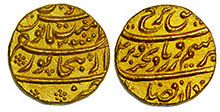Mohur

The mohur (from Persian muhr "seal", Persian موهر; Nepalese मोहर Mohar ) is originally an Indian gold coin . It was introduced in 1562 under Mughal Emperor Akbar I (1556–1605) and minted until the 19th century. Other Indian states also adopted the mohur. Due to the fluctuating fine weight , it was rated differently over time. Since the reign of Aurangzeb (1658–1707), one mohur was equivalent to 16 silver rupees . The British East India Company set its value at 15 rupees in 1834. The last time British India minted a mohur with a rough weight of 11.664 grams and a fine weight of 10.692 grams in 1891 in the name of the Queen of Great Britain and Ireland and Empress of India Victoria . The last edition ever took place in the Rajput princely state of Jodhpur under Hanwant Singh (1947–1952).
In Nepal ran Mohar order, from around 1640 initially as a silver coin later as a gold coin until 1932 by the weighing 5.64 grams, Nepalese rupee (one rupee = 2 Mohar = 100 Paisa was replaced).

